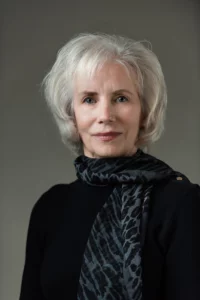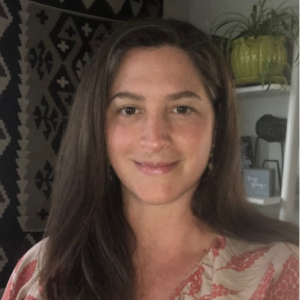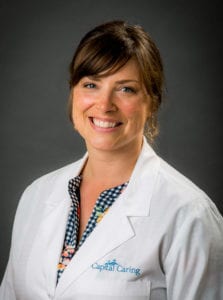And that’s no exaggeration. While many nonprofit organizations turn to community members to help them reach their goals, Capital Caring Health (CCH), as a Medicare-certified hospice, supplements paid staff with volunteers. The value of such help is clear: Nationwide, the average worth of a volunteer is $29.95 per hour, with that figure varying by geography. In Washington D.C., part of CCH’s service area, it jumps to $50.48!
Of course, even if we weren’t required to have volunteers, we’d still welcome them with open arms! After all, CCH was founded by a group of dedicated volunteers back in 1977. Today’s strong cadre of community helpers assures that we can meet our mission to provide the best quality, advanced illness and elder care, with warmth and compassion. From running errands to walking pets…from providing “goodie bags” to exhausted families to reading to a bedridden patient, our volunteers do everything except provide hands-on care.
Unfortunately, the COVID pandemic took a toll on CCH’s volunteer activities, eliminating in-person visitations altogether. Our volunteers quickly pivoted to meet the needs of our patients and their families, with no hesitation volunteers began to provide grocery shopping, phone calls, zoom visits, door step deliveries and much more. But now that we can welcome volunteers back into the fold, many opportunities await those who want to help and make a difference in the lives of others! Here are five reasons why to consider joining the CCH volunteer community.
1. CCH supports volunteers to share their gifts and talents while providing ongoing training
CCH volunteers boast a variety of backgrounds, professions, and skill sets. We have lawyers, teachers, hairstylists, chaplains, a Reiki master, acupuncturist, speakers of multiple languages, musicians and more. Some want to share their existing expertise, while others are eager to do something completely different. Either way, we can probably find a match for your interests and our needs. And the best part? All training will be provided.
That’s because CCH provides a comprehensive, 30-hour training program to all volunteers so you are well-prepared for whatever role you may choose. Following a screening and background check, new volunteers begin their education by completing a self-paced, online module to learn about life transitions, how hospice “does death differently,” and how to practice reflective listening. Next, an introduction specific to CCH explains how the organization works and all the services offered. Finally, for volunteers who choose to work with patients and families, a volunteer manager or experienced mentor will accompany them on their first in-home visit to provide real-time support.
In exchange, we ask for a commitment of six months to a year, with each volunteer contributing at least eight hours per month. However, the thoroughness and thoughtfulness of our approach must be working: While the average length of service is approximately five years, one volunteer has been with CCH an astonishing 37 years.
Put Your Passion and Skills to Good Use.
Lawyer Doug Davidson, the longest-tenured CCH volunteer, began his service as a patient and family visitor/companion. But after about six years, he discovered how many participants lacked basic, but necessary, legal documents such as a will and durable power of attorney; i.e., the act of designating someone to make decisions on your behalf. So Doug put his expertise to work, filling a gap for those in need by creating template legal documents and adding one more role to his other volunteer activities.
2. Follow Your Heart
“At CCH, there’s an endless pool of patient and family needs, which translates into nearly endless volunteer opportunities—everything but clinical care,” says Katherine Knoble, Director, Volunteer and Community Engagement.
The need is especially great for extra patient and family support. Nearly 95% of CCH patients receive professional care at home, along with daily assistance from family and/or friends. As such, it is often those unpaid family caretakers who need extra help with a range of essential activities. That includes everything from respite care—so a family member can just take an emotional and physical break from the challenge of caring for another—to running everyday but important errands.
At the other end of the spectrum lie special occasions and projects—always a favorite of CCH volunteers. From start to finish, volunteers are involved every step of the way, securing contributions of flowers, birthday cakes, and cookies; assembling Spring baskets; making cards, and more. In the process, they make an enormous difference to patients and families by creating positive memories.
Such activities are especially important to patients and families in our pediatric practice, a highly specialized service not offered by all hospices. This volunteer group of 80 strong gets caught up in creating fun birthday brigades and special monthly projects for children/young adults, their siblings, and parents. For example, CCH’s pediatric volunteers recently wore instantly recognizable tall, red and white striped hats while delivering Dr. Seuss books and other goodies for a Read Across America activity. Others outfitted in full bunny suits and bunny ears delighted children receiving Spring baskets.
Make Someone Happy!
Award-winning volunteer Laurie Manning, a self-confessed “costume collector” enjoys indulging her own love of dressing up while encouraging other volunteers to join in, all to delight pediatric patients and their families during special themed-events. She’s appeared as a superhero, Minnie Mouse, Princess Leia, and more!
3. Help Yourself While Helping Others
Even though many volunteers start out wanting to help others, they frequently find they’re helping themselves in the process. In fact, research reveals volunteers gain an array of benefits from providing service to others, including better physical health and mental health, improved moods, lower stress levels, an enriched sense of purpose in life, and other positive indicators.
While people volunteer for a variety of reasons, at CCH, the decision is often personal: About half of active volunteers experienced our hospice care first-hand with a loved one nearing the end of life. For them, volunteering serves as both a way to “give back” and an avenue to support a type of care that improves quality of life for critically ill patients and their families.
On the other hand, many others wish their own family had known about the invaluable benefit of hospice care when they needed it, and are eager to support the service for others.
As a consequence of helping others, many CCH volunteers meet new people and make lifelong friendships with staff members and fellow volunteers. Others simply derive a sense of satisfaction from contributing to the well-being of their own neighborhood or community throughout CCH’s service areas of Virginia, Washington, D.C., and Maryland.
Find Life-Enhancing Experiences.
“What brings me joy is just the impact I can have on a person in just a few minutes,” says volunteer Dana Siegel. “That keeps me coming back. Plus there’s no way you can begin to understand the impact volunteering at CCH can have on your own life and the way you live your life.”
4. Join A Community
To foster connection and support, CCH volunteers are organized into groups based on service area and the roles they play. For instance, we have sub-groups devoted to pediatric services, to adult visitation and companionship, and to active and retired members of the military who help patient/veterans. Groups meet both in person and virtually to share experiences, get advice and support, and foster friendships.
In addition, each group’s volunteer manager shares a weekly email that celebrates the group’s recent activities and achievements by individual volunteers along with photos. A systemwide monthly newsletter further informs volunteers about the depth and breadth of other CCH volunteer activities offered throughout all service areas. The regular communications allow volunteers to feel connected to all that CCH has going on, all over the region.
During April’s annual Volunteer Appreciation Week, volunteer managers further expressed their gratitude through flower deliveries, a happy hour at a local brewery, and more. Year-round, volunteers are encouraged and supported in myriad ways including a CCH Volunteer Facebook group and Instagram. This virtual interaction was especially important during the pandemic, helping volunteers to remain engaged with each other when they couldn’t meet in person.
You Give Your Heart, We’ve Got Your Back!
“For me, one of the key reasons I started volunteering with CCH and have remained an active volunteer is the tremendous support and encouragement I receive,” says award-winning volunteer and nurse Maria Lewan. As a volunteer recruiter, she also shares that one of the key components of volunteering is the wide range of opportunities. “This allows great flexibility in the commitment to volunteering—CCH is unique in that realm.”
5. Ready to Help?
The pandemic had a devastating impact on volunteering: Across the board, 66% of volunteers nationwide either decreased their hours or stopped volunteering completely. CCH was severely affected, as all in-person volunteer visits abruptly came to a halt. Nevertheless, some determined individuals found warm and safe ways to help counter isolation and loneliness among CCH patients during that time. For their devotion, they have earned our eternal gratitude and that of the patients and families they helped.
However, nothing is the same as spending time in person and we are thrilled to welcome back a number of our volunteers. Still, there’s always more to be done and CCH is looking for help with special events in neighborhoods, behind-the-scenes support, and always, patient and family assistance. For Katherine Knoble “as we seek to attract more volunteers, we’re excited so many young professionals are responding after hearing about our local events through social media or learning about CCH from a day of service through their workplace.”
If you’d like to learn more, we’d love to hear from you! Just click here for more information. You may be surprised at all the different ways you can make a difference!


 Dr. Cheryl-Lynne McCalla, DO
Dr. Cheryl-Lynne McCalla, DO Kathleen Ramkaran, RN, CCM
Kathleen Ramkaran, RN, CCM Hali Gantumur
Hali Gantumur Yasmin
Yasmin  Jennifer Olsen GNP-BC
Jennifer Olsen GNP-BC Meena Raj, MD,
Meena Raj, MD, 

 Kimberly Grove
Kimberly Grove
 Pat Bishop
Pat Bishop Elizabeth Ariemma
Elizabeth Ariemma Ray Jay Garcia, M.D.
Ray Jay Garcia, M.D.
 Heidi Young
Heidi Young Matt Kestenbaum
Matt Kestenbaum
 Anne Silao-Solomon, M.D.
Anne Silao-Solomon, M.D. Matthew Irwin, M.D., M.S.W.
Matthew Irwin, M.D., M.S.W. Catherine McGrady, RN, MSN, is Vice President, Clinical Programs at Capital Caring Health. In this role she is responsible for the development, implementation, and monitoring of clinical programs in support of high-quality patient-centered care delivery across the continuum of services. Catherine also manages external partnerships including Capital Caring Health’s participation in ACOs and other value-based clinical programs
Catherine McGrady, RN, MSN, is Vice President, Clinical Programs at Capital Caring Health. In this role she is responsible for the development, implementation, and monitoring of clinical programs in support of high-quality patient-centered care delivery across the continuum of services. Catherine also manages external partnerships including Capital Caring Health’s participation in ACOs and other value-based clinical programs Jason Sobel, MD
Jason Sobel, MD Kremena Bikov
Kremena Bikov Stacy Brown
Stacy Brown Jackie Gouline
Jackie Gouline Susan Roberts
Susan Roberts Brenan Nierman
Brenan Nierman Annette Lindsay
Annette Lindsay Shannon Collier
Shannon Collier Carla Thompson
Carla Thompson Gabby True
Gabby True Evan Kirschner
Evan Kirschner Margaret Doherty
Margaret Doherty Henry Fuller
Henry Fuller Jennifer Godwin
Jennifer Godwin Sally Hughes
Sally Hughes LaWanda Middleton
LaWanda Middleton Hope Collazo
Hope Collazo Odessa Simpson
Odessa Simpson Anne Young
Anne Young Sherri Parker
Sherri Parker Catherine Kravolec
Catherine Kravolec Heidi Young, M.D.
Heidi Young, M.D.
 Hank Willner, M.D.
Hank Willner, M.D. Audrey Easaw
Audrey Easaw Julia Feldman
Julia Feldman Gus has been a part of the Capital Caring Health family for nearly fifteen years. Ten of those years have been in leadership, working with colleagues and co-workers to achieve the best in their ability while promoting CCH core values. Gus has a background in nursing and a lifelong passion for technology. In each position at CCH, Gus has found ways to integrate technology to enhance outcomes and job satisfaction.
Gus has been a part of the Capital Caring Health family for nearly fifteen years. Ten of those years have been in leadership, working with colleagues and co-workers to achieve the best in their ability while promoting CCH core values. Gus has a background in nursing and a lifelong passion for technology. In each position at CCH, Gus has found ways to integrate technology to enhance outcomes and job satisfaction.
 Linda Biedrzycki
Linda Biedrzycki Joe Murray
Joe Murray Lin Maurano
Lin Maurano Laura Branker
Laura Branker Cameron Muir, M.D.
Cameron Muir, M.D. Cameron Muir, M.D.
Cameron Muir, M.D. Fellowship
Fellowship Lee-Anne West, M.D.
Lee-Anne West, M.D.
 Steve Cone
Steve Cone

 Kieran Shah
Kieran Shah Altonia Garrett
Altonia Garrett Jason Parsons
Jason Parsons Nancy Cook
Nancy Cook Michael Byas-Smith, M.D.
Michael Byas-Smith, M.D. Olubukola Bolaji, M.D.
Olubukola Bolaji, M.D. Jennifer Gerhard, D.O.
Jennifer Gerhard, D.O. Hershell Foster
Hershell Foster Michael Toohig’s Story
Michael Toohig’s Story Liberating Europe
Liberating Europe Marrygold Ugorji’s Story
Marrygold Ugorji’s Story Sherri Parker, Team Leader Medical Social Worker
Sherri Parker, Team Leader Medical Social Worker Colleen Carberry, RN Case Manager
Colleen Carberry, RN Case Manager Paulette Davidson, Chaplain
Paulette Davidson, Chaplain Donna Smith
Donna Smith Tabitha Gingerich, NP
Tabitha Gingerich, NP Dwayne Barton, NP
Dwayne Barton, NP Caitlin Geary
Caitlin Geary Sayaka Hanada
Sayaka Hanada Sherri Parker
Sherri Parker
 Mandy Brouillard
Mandy Brouillard Tamara Barnes, M.D.
Tamara Barnes, M.D. Alan Goldblatt, M.D.
Alan Goldblatt, M.D. Amanda Keerbs, M.D.
Amanda Keerbs, M.D. Adam Knudson, M.D.
Adam Knudson, M.D. Peyman Mamdouhi, D.O.
Peyman Mamdouhi, D.O. John McCue, D.O.
John McCue, D.O. Christopher Pile, M.D.
Christopher Pile, M.D. Maleeha Ruhi, M.D.
Maleeha Ruhi, M.D. Mohammad Saleem, M.D.
Mohammad Saleem, M.D. Jason Sobel, M.D.
Jason Sobel, M.D. Carolyn Richar
Carolyn Richar Susan Boris
Susan Boris Keith Everett
Keith Everett Vivian Hsia-Davis
Vivian Hsia-Davis David Schwind
David Schwind Eric De Jonge, M.D.
Eric De Jonge, M.D. Melissa McClean, N.P.
Melissa McClean, N.P. Shaz Anwar, D.O.
Shaz Anwar, D.O. Petros
Petros  Neil Parker’s Story
Neil Parker’s Story Sulaiman Bangura’s Story
Sulaiman Bangura’s Story Steven Skobel’s Story
Steven Skobel’s Story